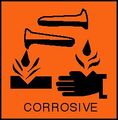Potassium Hydroxide material data safety sheet. Reproduced with kind permission of the Department of Chemistry, Oxford University.
Last updated January 18, 2007
| Common synonyms |
|
| Formula |
KOH
|
| Properties |
- Form: White semi-transparent flaky solid.
- Stability: Stable, but hygroscopic. Absorbs carbon dioxide from the air.
- Melting point: 360°C
- Water solubility: high (dissolution is very exothermic).
- Specific gravity: 2.04
|
| Principal hazards |
- Contact with the eyes can cause serious long-term damage.
- The solid and its solutions are corrosive.
- A significant amount of heat is released when potassium hydroxide dissolves in water; this may be sufficient to crack thin glassware if the solution is not stirred when dissolving the solid.
|
| Safe handling |
- Always wear safety glasses.
- Do not allow solid or solution to come into contact with your skin.
- When preparing solutions swirl the liquid gently to prevent "hot spots" developing.
|
| Emergency |
- Eye contact: Immediately flush the eye with plenty of water. Continue for at least ten minutes and call for immediate medical help.
- Skin contact: Wash off with plenty of water. Remove any contaminated clothing. If the skin reddens or appears damaged, call for medical aid.
- If swallowed: Drink plenty of water and call for immediate medical help.
|
| Disposal |
- Small amounts of dilute potassium hydroxide can be flushed down a sink with a large quantity of water, unless local rules prohibit this.
- Larger amounts should be neutralised before disposal.
|
| Protective equipment |
- ALWAYS wear safety glasses when handling potassium hydroxide or its solutions. For many chemicals safety glasses are needed because when the chemical gets in the eye it causes irritation; by contrast, potassium hydroxide can cause serious damage.
- If you need gloves, neoprene, nitrile or natural rubber are suitable for handling solutions at concentrations of up to 70%.
|
| Further information |
More extensive safety data |
Bio-rich-time-poor 21:07, 25 June 2011 (BST)

